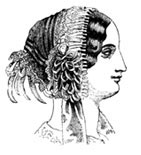
“The Birth-mark.” By Nathaniel Hawthorne.
LITERATURE MATTERS
Man has long been alive to the many ways in which his body decays and perishes, the ways his body is fallible and imperfect. Unique among God’s creatures, man also has the power of imagination and, consequently, the ability to shape his environment and himself. With that power, though it is far from omnipotent, comes responsibility. One of the oldest continuing moral dilemmas, in fact, concerns man’s response to the questions of mortality and imperfection. Should we aspire to extend human life indefinitely? Should we try to repair our imperfections using our human ingenuity and genius? In other words, should man aspire to control nature? Should he aspire to play God?
One of Nathaniel Hawthorne’s many compelling short stories perfectly captures this ancient dilemma. “The Birth-mark” is the tale of Aylmer, a late-19th-century idealist whose love for science rivals his love for his wife. Georgiana is an otherwise perfectly beautiful young woman with a small hand-shaped birthmark on her left cheek. One day, soon after their wedding, Aylmer asks Georgiana, “Has it ever occurred to you that the mark upon your cheek might be removed?” This shocks his wife because, as she explains, she’s always thought of it as a charm, as much a part of her as the rest of her body. In fact, many a man “would have risked life for the privilege of pressing his lips to the mysterious hand.”
What seems at first like an insignificant and offhand question, albeit a loutish one, quickly escalates to an obsession. Aylmer wants the birthmark, that “tint of deeper crimson,” removed from his wife’s face. He says he wants Georgiana as perfect as Pygmalion’s marble Galatea: “Seeing her otherwise so perfect, he found this one defect grow more and more intolerable with every moment of their united lives.” (Recall that Pygmalion was a misogynist sculptor who found women so unattractive he made a “perfect” one out of stone.) Every conversation during their honeymoon period is tainted by Aylmer’s obsession. He invariably reverts to this one topic every time he sees her. In fact, it doesn’t seem that he sees Georgiana at all, but only her birthmark: “With the morning twilight Aylmer opened his eyes upon his wife’s face and recognized the symbol of imperfection; and when they sat together at the evening hearth his eyes wandered stealthily to her cheek, and beheld, flickering with the blaze of wood fire, the spectral hand that wrote mortality.”
As his obsession progresses, Aylmer begins to draw back in disgust at the sight of the birthmark. He is convinced that he should correct what nature left imperfect, and he devotes his every waking hour to concocting just the right potion that will do the trick. This birthmark is no superficial blemish, easily removed, like a mole. No, Aylmer tells Georgiana, her hand-shaped birthmark runs deep, and is intertwined into her very fabric.
You May Also Enjoy
Swift’s struldbrugs inspire consideration of the abiding human passion to prolong life indefinitely. But by losing our mortality, do we also lose our humanity?
The cultivation of leisure, friendship, good cooking, and delightful storytelling are never learned if everyone is too busy or too lazy to be host or guest.
GKC did believe creation and its Creator are good, but not that the majority of people would always choose rightly or that any merely human structure would endure.

